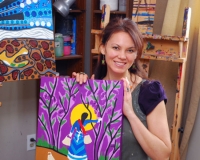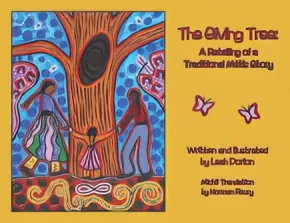
Leah Marie Dorion
Leah Dorion, originally from Prince Albert, Saskatchewan, is a Métis artist, author, curriculum developer, lecturer, and researcher. She has taught Métis History and Native Studies for the First Nations University of Canada, the Gabriel Dumont Institute (GDI), and the University of Saskatchewan. For eight years, she was employed in GDI's Publishing Department: first as a Curriculum Developer and later as a Publishing Coordinator. She has authored or contributed to numerous books including The Snow Tunnel Sisters, Métis Legacy I and II, and Drops of Brandy. Currently, Leah is a visual artist, and an instructor at the Saskatchewan Urban Native Teacher Education Program, Prince Albert.
Kids Books (5)
Strong Stories Métis: The Helpful Sasquatch
 $9.95
$9.95

Artists:
Format:
Paperback
Text Content Territories:
Indigenous Canadian; Métis;
ISBN / Barcode: 9781771743204
Synopsis:
Synopsis:
A playful story about how Sasquatch is always being helpful. Sasquatch is honoured with an offering of food to show gratitude. What is something that you do to show gratitude?
Educator & Series Information
Recommended for intermediate students (grades 4-6).
The Helpful Sasquatch is part of the Strong Stories: Métis series. Strong Stories focus on different First Nation territories from across Canada and the United States. These stories reflect the belief that our stories are the roots of our people, our lands and our cultures. It is from our stories that we grow and become strong and proud.
Additional Information
16 pages | 6.00" x 9.00" | ISBN: 9781771743204
Strong Stories Métis: The Story of the Tamarack Tree
 $9.95
$9.95

Artists:
Format:
Paperback
Text Content Territories:
Indigenous Canadian; Métis;
ISBN / Barcode: 9781771743211
Synopsis:
Synopsis:
Creator advised us not to compare ourselves to each other. We all have a special place within the circle of life. What do you think happens when Tamarack seeks the attention of the Muskeg people?
Educator & Series Information
Recommended for intermediate students (grades 4-6).
The Story of the Tamarack Tree is part of the Strong Stories: Métis series. Strong Stories focus on different First Nation territories from across Canada and the United States. These stories reflect the belief that our stories are the roots of our people, our lands and our cultures. It is from our stories that we grow and become strong and proud.
Additional Information
16 pages | 6.00" x 9.00" | ISBN: 9781771743211
The Diamond Willow Walking Stick (2 in Stock-Out of Print)
$17.50
Artists:
Format:
Paperback
Text Content Territories:
Indigenous Canadian; Métis;
ISBN / Barcode: 9781926795096
Synopsis:
Synopsis:
Leah Marie Dorion's The Diamond Willow Walking Stick: A Traditional Métis Story About Generosity focuses on a Métis Elder's remembrances of traditional teachings about generosity that were taught to him by his grandparents during his childhood. These lifelong lessons imparted on him "how to live in a good Métis way," and taught him how to live with respect within the circle of life. In this charming children's book, the third in an ongoing series on traditional Métis culture, author and illustrator Leah Marie Dorion takes the reader on another enchanting journey while once again honouring the special bond between Métis children and their grandparents. With breathtaking artwork and an elegant Michif translation by Norman Fleury, this heartfelt, coming of age story will resonate with both young and old. This book also includes a chart on the uses of the willow tree and an accompanying narration CD in English and Michif-Cree. This retelling of a traditional Métis story is most suitable for younger children.
Educator Information
This book also includes a chart on the uses of the willow tree and an accompanying narration CD in English and Michif-Cree.
This retelling of a traditional Metis story is most suitable for younger children.
Additional Information
56 Pages | 28 cm x 21.5 cm
The Giving Tree: A Retelling of a Traditional Métis Story
$17.50
Artists:
Format:
Paperback
Text Content Territories:
Indigenous Canadian; Métis;
ISBN / Barcode: 9780920915905
Synopsis:
Synopsis:
This charming story, richly steeped in Métis culture, focuses on the boyhood reminisces of Moushoom as her describes finding the "great giving tree" with his mother and father. The story emphasizes the Métis core values and beliefs including strength, kindness, courage, tolerance, honesty, respect, love, sharing, caring, balance, patience, and most of all, the important connection with the creator and Mother Earth.
Additional Information
50 Pages | 27.9 cm H x 21.5 cm W
We Are All Connected: Métis, Wetlands and Mallards
 $21.95
$21.95

Format:
Paperback
Text Content Territories:
Indigenous Canadian; Métis;
ISBN / Barcode: 9781771742511
Synopsis:
Synopsis:
“We Are All Connected” is a series that explores how we all live together in a shared balance upon Mother Earth. Each book explores a specific ecosystem with a focus on one animal and its adaptations for survival within that ecosystem. Indigenous interviewees, each living within the same area, have responded to strategic questions as to how their community interacts with the land, their traditional territory. Explore each text with a sense of inquiry in mind.
8 We Are All Connected Titles Coast Salish, Coastal Rainforests and Cougars Haisla, Rivers and Chinook Salmon Inuit, Tundra and Ravens Lakota, Mixed Grasslands and Bald Eagles Métis, Wetlands and Mallards Nisga'a, Ponds and Leopard Frogs Nlaka'pamux, Grasslands and Rattlesnakes Sto:lo, Riparian Forests and Black Bears Each title covers the following curricular areas. Traditional storytelling and artwork begin each title from the focus Indigenous territory. Science: Biodiversity, classification, life cycles, food chains, food webs and connections between living and non-living things are just some of the science concepts included in each book. Social Studies: Contemporary and historical Indigenous cultural knowledge flows throughout each book. Local land forms, gatherings, harvesting practices and government are some of the social studies concepts included in each book.
2 Foundation Titles The two foundational books provide deeper understanding of the content of the “We Are All Connected” titles. We Are All Connected: The Earth, Our Home- explores biomes, ecosystems and biodiversity. We Are All Connected: The Earth, We Share- explores the interconnectedness between living and non-living things.
Authenticity Note: This book contains some Indigenous artwork and photos throughout, such as artwork from Leah Marie Dorion.
Additional Information
32 pages | 8.50" x 11.00" | ISBN: 9781771742511












